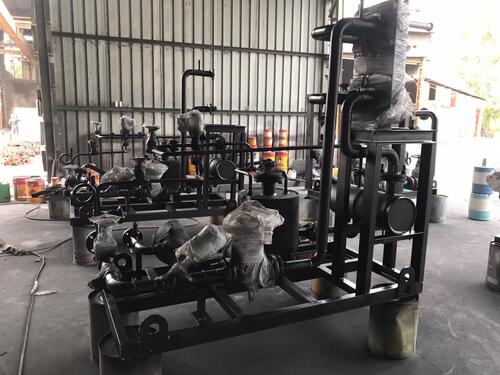About Skid System
A skid system, often referred to as a skid-mounted or skid-based system, is a pre-engineered and pre-assembled assembly of equipment and components mounted on a common frame or base, known as a skid. These systems are designed to be easily transported, installed, and operated in various industrial applications. Skid systems are used in a wide range of industries, including oil and gas, chemical processing, water treatment, and manufacturing.
Key Features and Benefits
-
Modular Design:
- Pre-Assembled: Equipment and components are assembled and tested on the skid before delivery, minimizing installation time on-site.
- Standardized: Typically built to standard sizes and configurations, which can simplify integration and maintenance.
-
Ease of Transportation:
- Portable: Skid systems are designed to be transported easily, often via truck or shipping container.
- Quick Setup: Reduces the need for extensive on-site assembly, allowing for faster commissioning.
-
Flexibility:
- Customizable: Can be customized to fit specific operational needs, including different sizes, configurations, and equipment types.
- Scalable: Easy to add or modify components as needed to accommodate changes in process requirements.
-
Cost-Effective:
- Reduced Labor Costs: Pre-assembled systems can reduce labor costs associated with on-site assembly and installation.
- Efficient Use of Space: Optimizes the use of space by integrating multiple components into a compact unit.
Common Types of Skid Systems
-
Pump Skid Systems:
- Purpose: Integrate pumps with associated piping, valves, and controls.
- Applications: Used in fluid transfer, water treatment, and chemical dosing.
-
Process Skid Systems:
- Purpose: Combine process equipment such as reactors, heat exchangers, and separators.
- Applications: Employed in chemical processing, pharmaceutical manufacturing, and food and beverage production.
-
Filtration Skid Systems:
- Purpose: Include filtration units such as bag filters, cartridge filters, and membrane systems.
- Applications: Used in water and wastewater treatment, and in various industrial processes requiring fluid filtration.
-
Cooling and Heating Skid Systems:
- Purpose: Contain components like chillers, heaters, and associated control systems.
- Applications: Used in HVAC systems, process cooling, and heating applications.
-
Compressor Skid Systems:
- Purpose: Integrate compressors with associated equipment such as dryers, separators, and controls.
- Applications: Used in compressed air systems, gas processing, and industrial applications requiring compressed gases.
Design Considerations
-
Size and Configuration:
- Footprint: Ensure the skid system fits within the available space at the installation site.
- Component Layout: Optimize the arrangement of equipment for efficient operation and maintenance.
-
Material Selection:
- Corrosion Resistance: Choose materials suitable for the operating environment and fluids handled.
- Durability: Ensure that the skid and its components are robust enough for the operating conditions.
-
Safety:
- Compliance: Design the skid system to meet industry safety standards and regulations.
- Access: Provide adequate access for maintenance and emergency situations.
-
Integration:
- Compatibility: Ensure that the skid system integrates seamlessly with existing infrastructure and systems.
- Control Systems: Include necessary control and monitoring equipment to manage the skids operation.
Maintenance and Troubleshooting
-
Regular Inspections:
- Visual Checks: Regularly inspect the skid system for leaks, wear, and damage.
- Functional Tests: Perform routine tests to ensure all components are operating correctly.
-
Cleaning:
- Scheduled Maintenance: Implement a cleaning schedule based on the type of fluids and contaminants handled.
-
Component Replacement:
- Worn Parts: Replace any components that show signs of wear or malfunction to prevent system failure.
-
Documentation:
- Records: Maintain detailed records of maintenance activities, inspections, and any issues encountered.
Common Challenges
- Space Constraints: Ensuring the skid system fits within the available space while accommodating all required components.
- Transport and Handling: Safely transporting and handling the skid system to prevent damage.
- Integration Issues: Ensuring compatibility with existing systems and infrastructure.
Skid systems offer a versatile and efficient solution for many industrial applications. If you need more detailed information or have specific requirements for a skid system, feel free to ask!





